1lumen selects and reviews products personally. We may earn affiliate commissions through our links, which help support our testing.
NEXTORCH E51C review
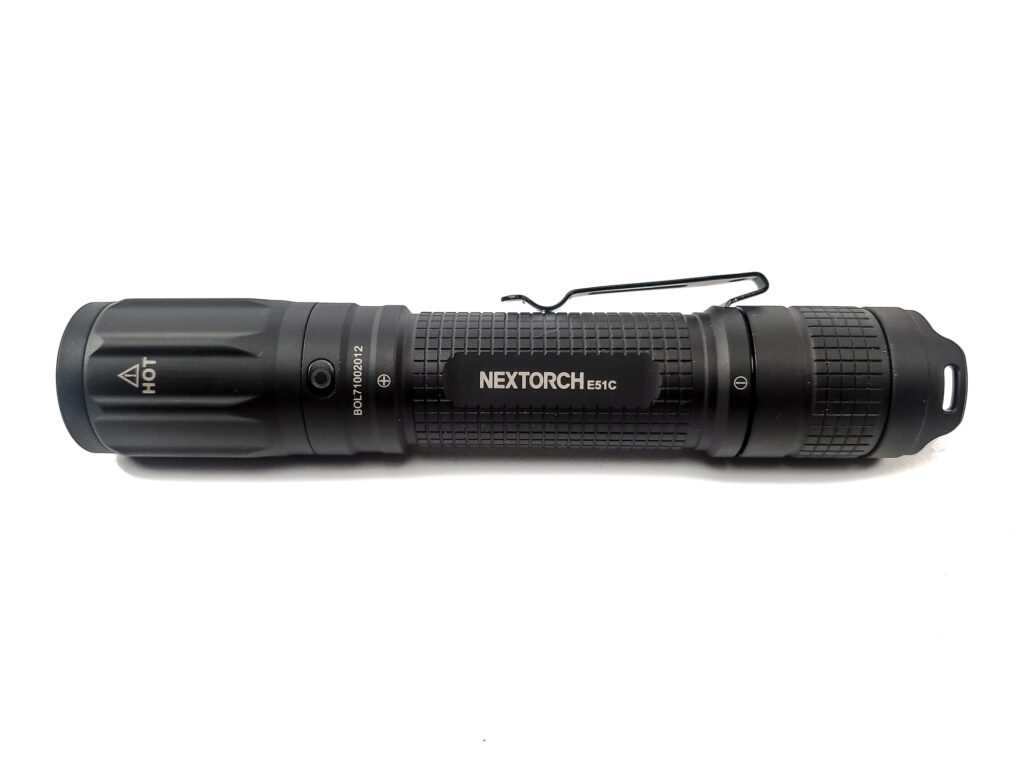
NEXTORCH E51C specifications
| Brand & Model | NEXTORCH E51C |
|---|---|
| Flashlight category | EDC / TACTICAL |
| LED | Osram P9 |
| Max. output | 1600 lumens |
| Max. beam distance | 205 meters |
| Max. beam intensity | 10,506 cd |
| Battery config. | 1*18650 |
| Onboard charging | USB-C Onboard |
| Modes | 3 |
| Blinkies | Strobe |
| Waterproof | IPX8 |
| Review publication date | January 2023 |
Introduction:
NEXTORCH is known for their tactically oriented flashlights and law enforcement gear. They supply many products to over 100 countries and agencies around the world. Their “TA” line is the most tactical in the lineup, but they have others as well. The “E” line is a smaller framed, more easily carried set of lights that is designed to fit under the EDC spectrum. More streamlined is the name of the game for the “E” series and specifically with the E51C, it is an incremental upgrade from their previous version, the E51. More lumens, single input method, and ease of charging with updated USB-C are the biggest players in this game. So, let’s see if they have what it takes to come out on top, or if the roster needs pruning to make way for better players.
Package quality.
The E51C is shipped in a thick white cardstock box with the NEXTORCH logo and photos of the light out front and center. The back and one side have company information and specifications while the other side is a little more peculiar. The light did ship with a battery, and it came preinstalled in the light, with a battery isolator pad stopping parasitic draw while en route. The plastic sleeve that held the actual light in place was quite snug, and upon initial inspection, I believed it had left small wear (rub) marks around the bezel but they easily wiped away with just a dry finger. All of the other items came in a plastic bag to stop them from thrashing about. All in all, everything was well packaged and, in the box, everything included is:
- NEXTORCH E51C
- 18650 Battery (preinstalled)
- User Manual
- Spare O-Rings
- Lanyard


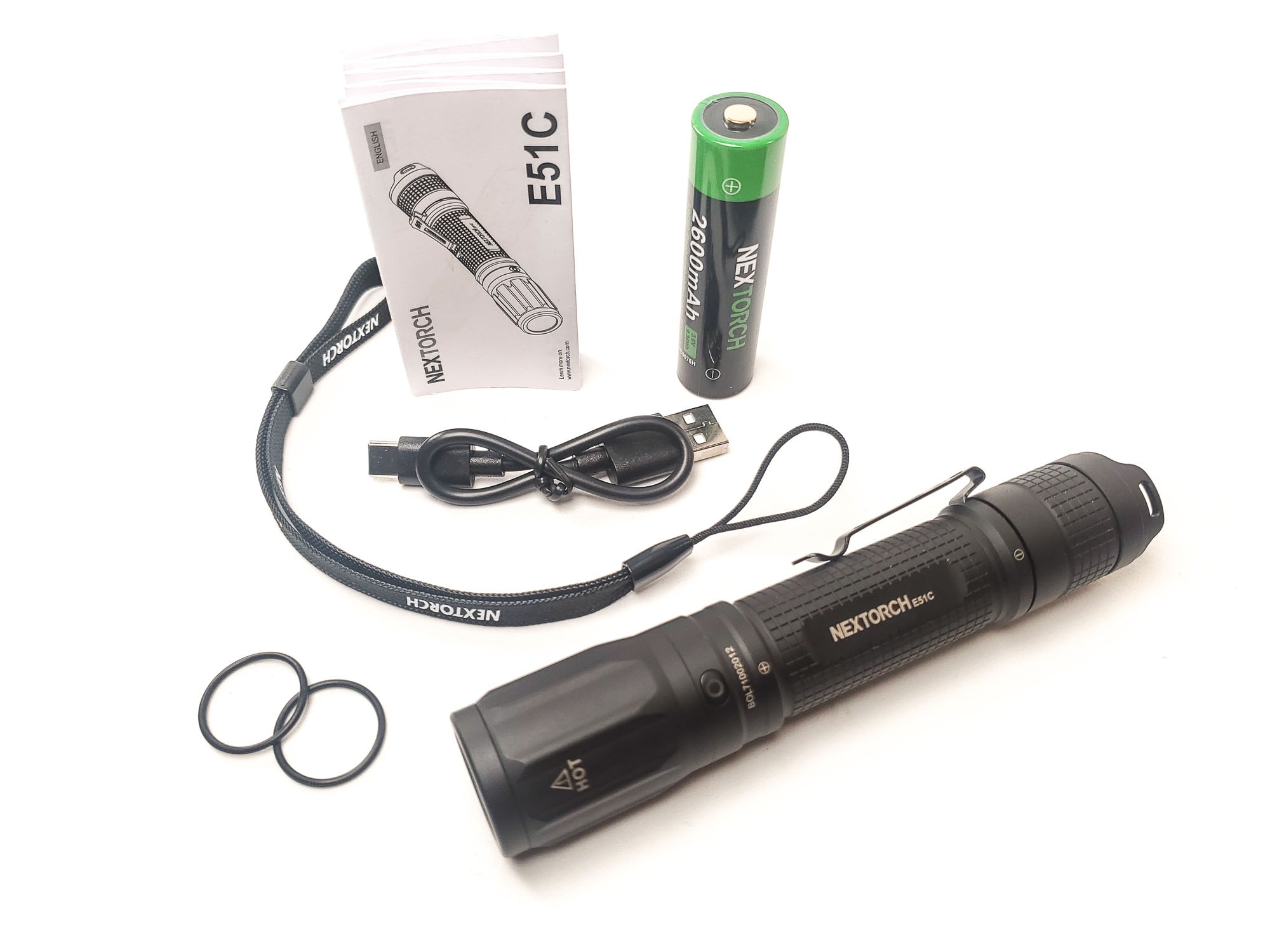
Flashlight in use
Believe it or not, this is my fourth foray into NEXTORCH lights. I personally own an E51 from a few years back and it was a delight to see how they decided to make the upgrades they did. The E51C is composed completely of an aluminum alloy (I am assuming 6061 as its pretty well the standard) and covered in a very consistent Type III hard anodized coating.
NEXTORCH is not one to, as one might say, have all of the fancy colors. The intended use for the majority of their products are tactical use, so having a pink or chrome flashlight just doesn’t make too much sense. What they do offer though, is black, and it looks dressed to impress. The knurling is square cut and provides a tactile grip wherever and however you might be holding it. This is almost completely covering the body of the light and extends onto the tailcap. The tailcap is a separate piece and provides the only user interaction with the function of the light.
There is a forward clicky switch that is housed and protected by radiused u-cuts, that also have provisions for a lanyard attachment. This makes it easy to identify and engage the cool aluminum tail switch in a momentary or fully activated fashion. This tail switch is also inset so, should you choose, you can tail stand the torch, although there isn’t too much meat there, what with the u-cuts and all.
The pocket clip is probably my favorite iteration from NEXTORCH so far. It seems to be the same captive clip as the others, but visually appears completely hidden where it wraps around the body. Very sleek, very cool. On the other end of the light, the head feels like it is missing something familiar. Without the strike beads I have seen in the past, the bezel seems to be rather boring. It is just black, but the head also gives you the only splash of color you’ll find on the E51C.
There is a small battery indicator just below a few anti-roll flats that will keep you in the loop as to the state of your battery. Fortunately, the business end of this light is only marginally larger than the rest of it, so it is easily pocketable. with the slender feel of this NEXTORCH, the usability, I feel, actually increases from a tactical flashlight to being able to use it daily. There are still tactical traits that are quite evident, but you’re not stuck in that small field.
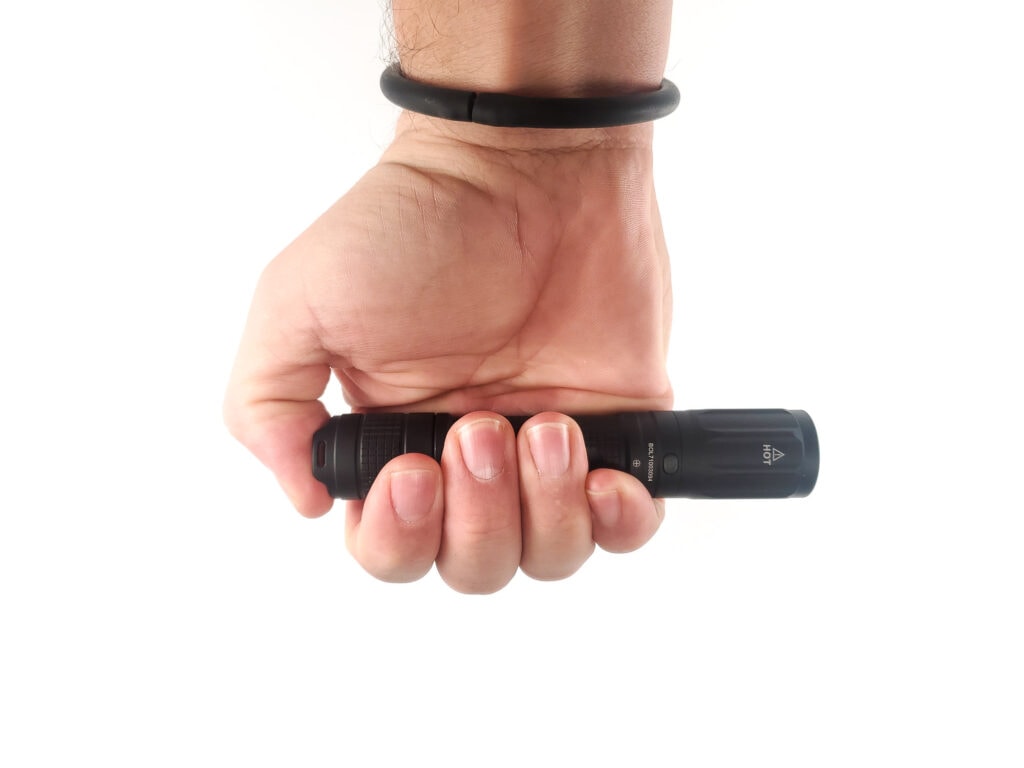

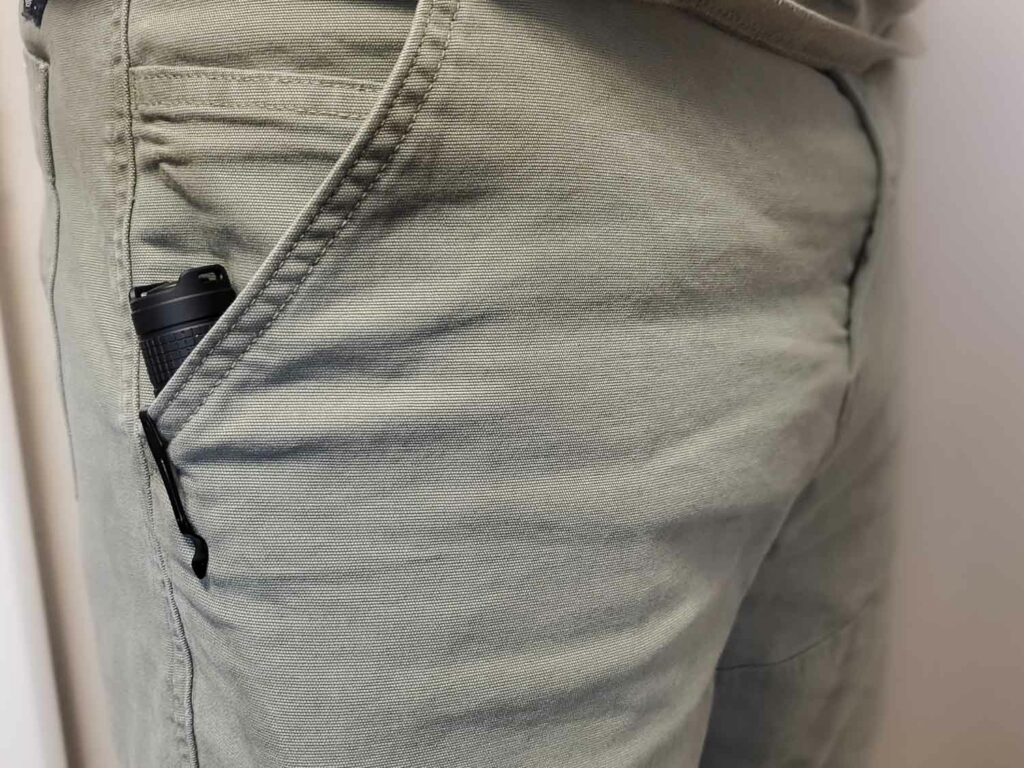
Build Quality, and Warranty
The build quality is EXACTLY what I have come to expect from NEXTORCH. The NEXTORCH E51C has an aluminum body made from 6061 aircraft grade aluminum and is covered in an incredibly even and durable Type III hard anodized matte black. The finish doesn’t seem to attract fingerprints or even oils from your hands and maintains its uniform finish through any use I have personally put it through. In addition to the finish staying uniform, the grip is also consistent and aggressive.
The body and tail have a squared knurling that helps you maintain a positive engagement at all times. Also on the tailcap, you have a forward clicky switch that will let you both blast your light in momentary as well as select what mode you want to use before making a full click to lock it in. While the spring in the rear tail switch gave decent feedback, I felt it may be a little too long of travel with no response. While this provides a large window for momentary (which I really liked), at times I felt as though I was certain I had released enough to change modes when in fact I hadn’t. At times it did seem a bit vague, so I did have to retrain my brain to essentially let go of the button entirely, albeit very quickly, to change modes.
If you remove the tailswitch, you can see the threads are anodized, square cut and provide just enough functional lubrication. It isn’t messy but the o-ring won’t tear from friction anytime soon. These threads also provide the only source of lockout with a quarter turn, as there is no software lockout available.
The back of the E51C isn’t the only place you’ll find threads though, as the head unscrews, but stays attached, to give you a means to recharge your light. The USB-C charging port is hidden underneath the head of the light and is o-ring sealed. You most definitely will notice the pressure of squeezing the o-ring when you need to charge this light, but it gives a sense of security that it’ll do its job of keeping water out and it will do it well.
The pocket clip has a hole cut into it for a lanyard to be able to attach, or you can attach it to the cut-outs on the saddle of the tailcap. The lanyard itself seems to be cut from the same cloth as every other generic lanyard out there, with the exception that it is branded with the NEXTORCH name, over and over again. If this is your only NEXTORCH light, you’ll never accidentally put the wrong lanyard on it.
Everything seems well enough compiled and no other issues reared towards me to make mention of, but if yours happens to come up with anything out of the ordinary, you’ll be pleased to note that NEXTORCH does warranty the E51C for a full 5 years and the included battery is covered for 1 year. The warranty information is available in the user manual, if you ever need to find this information again.
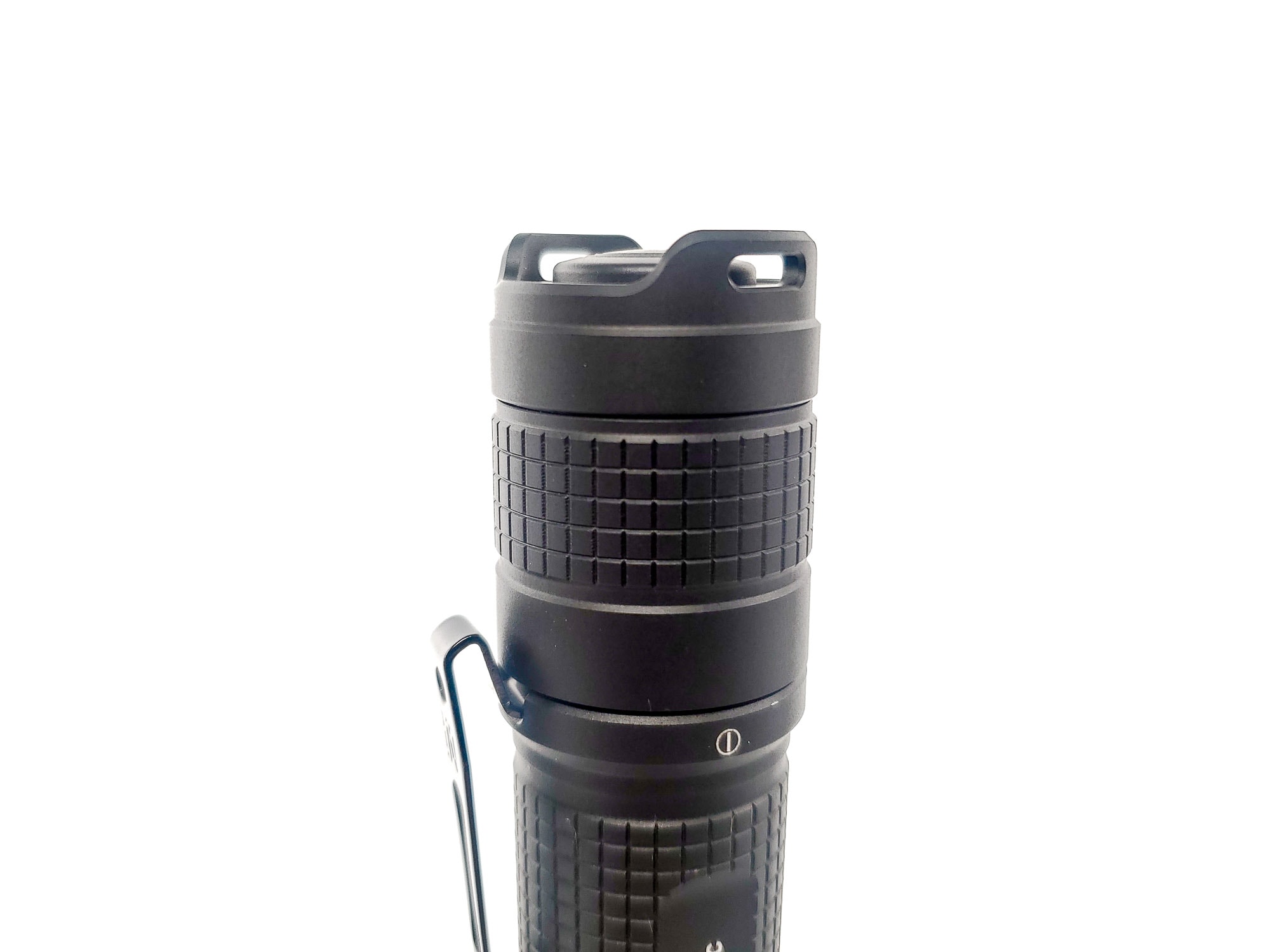
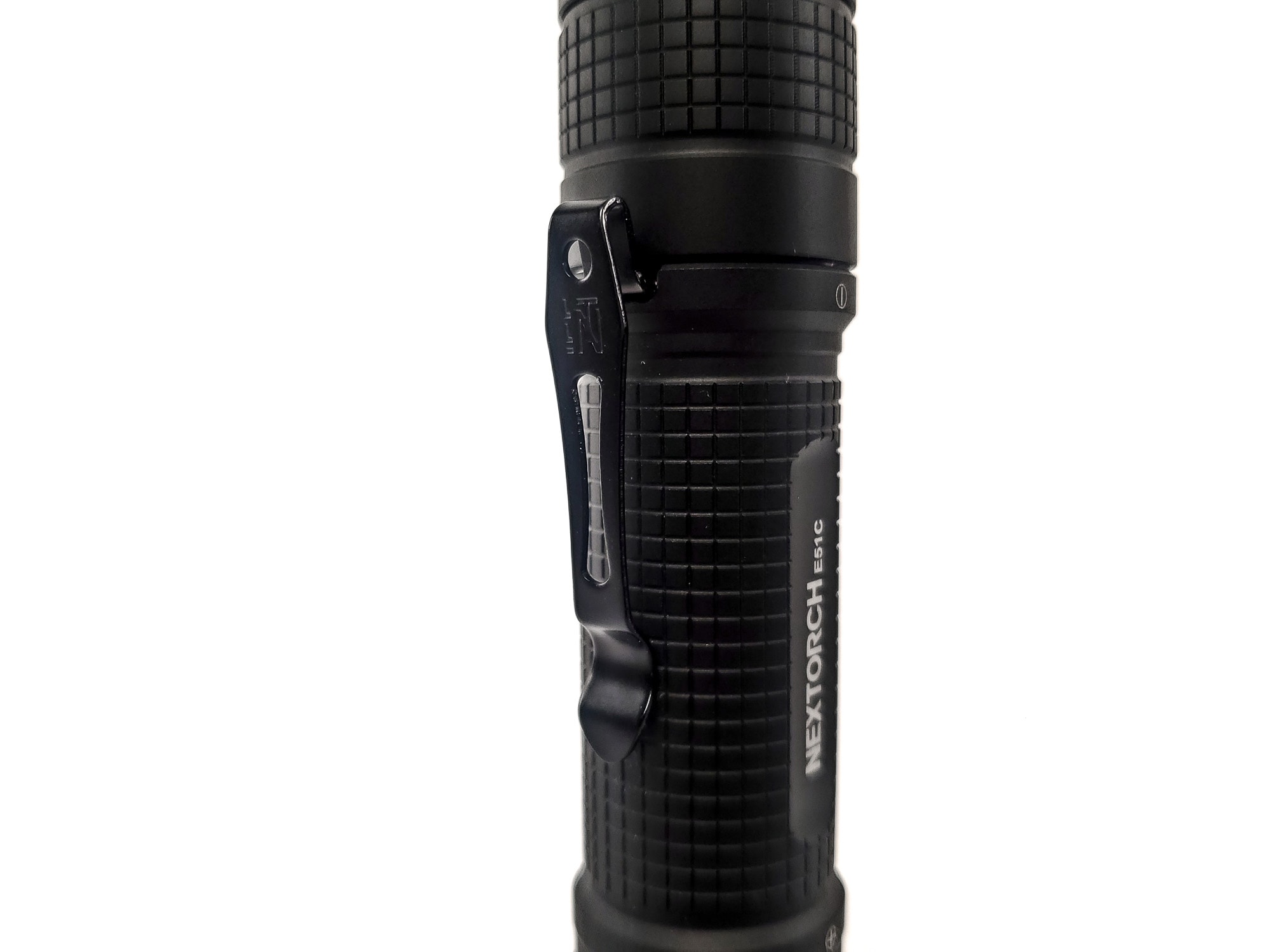
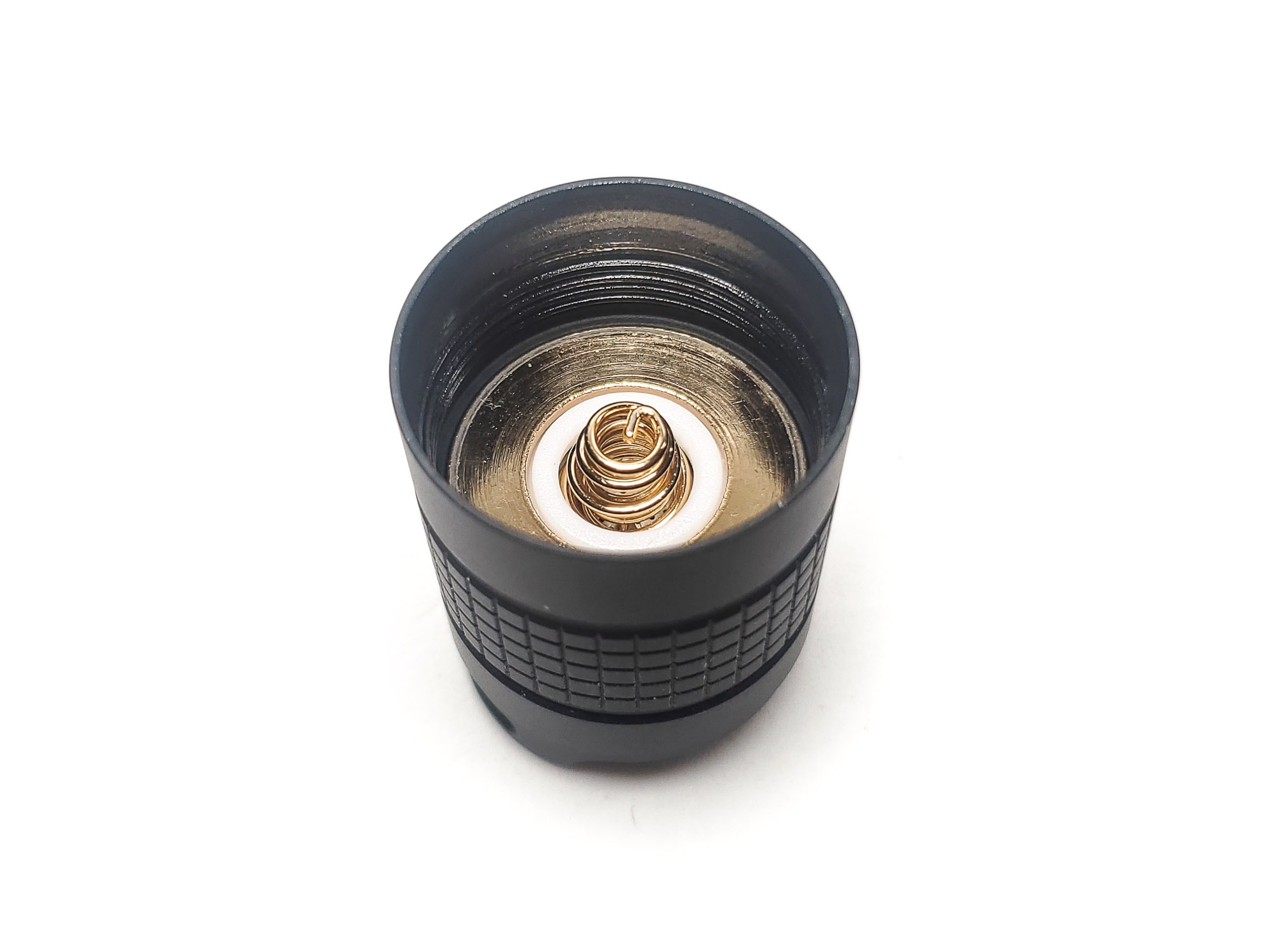
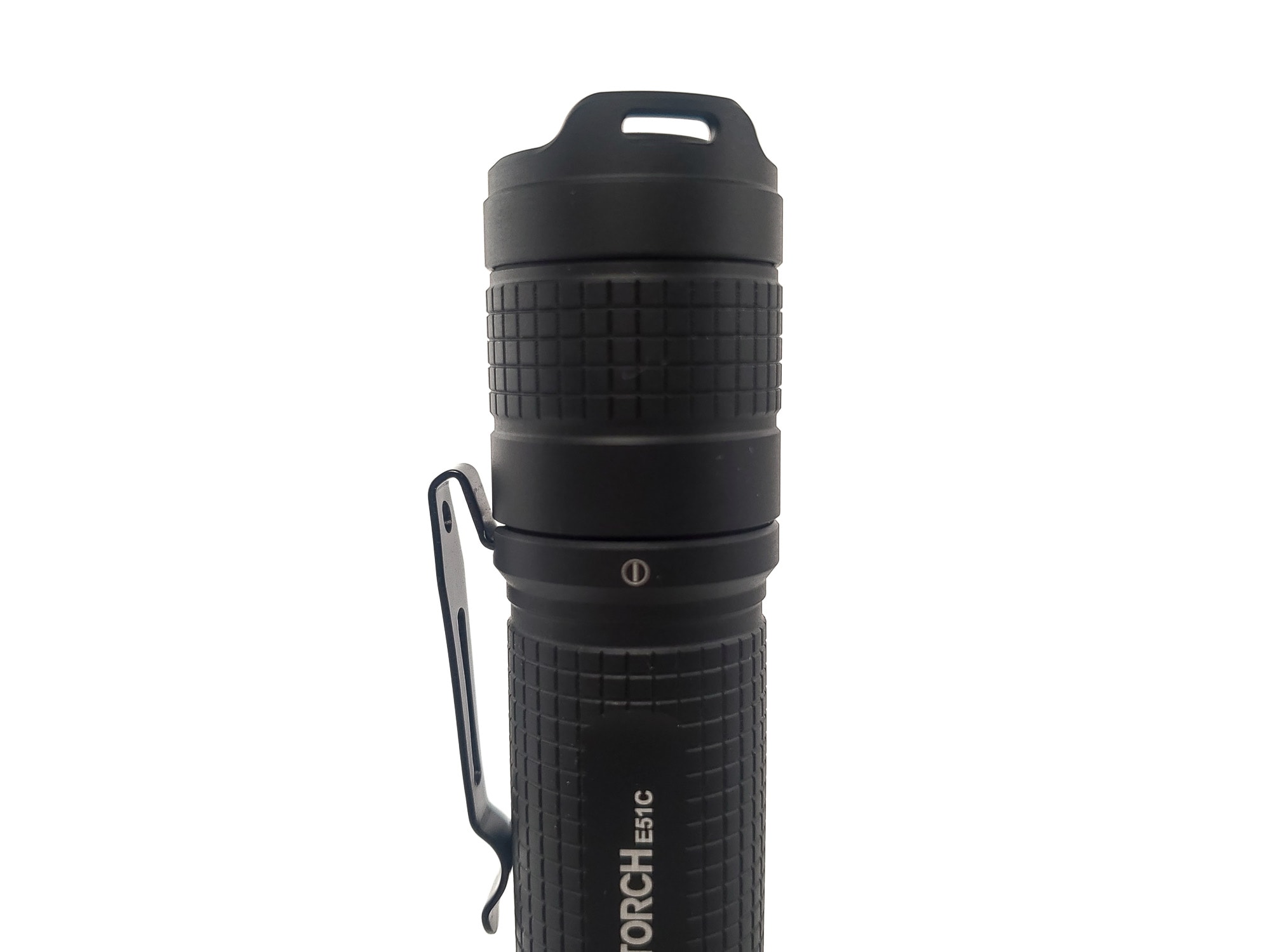

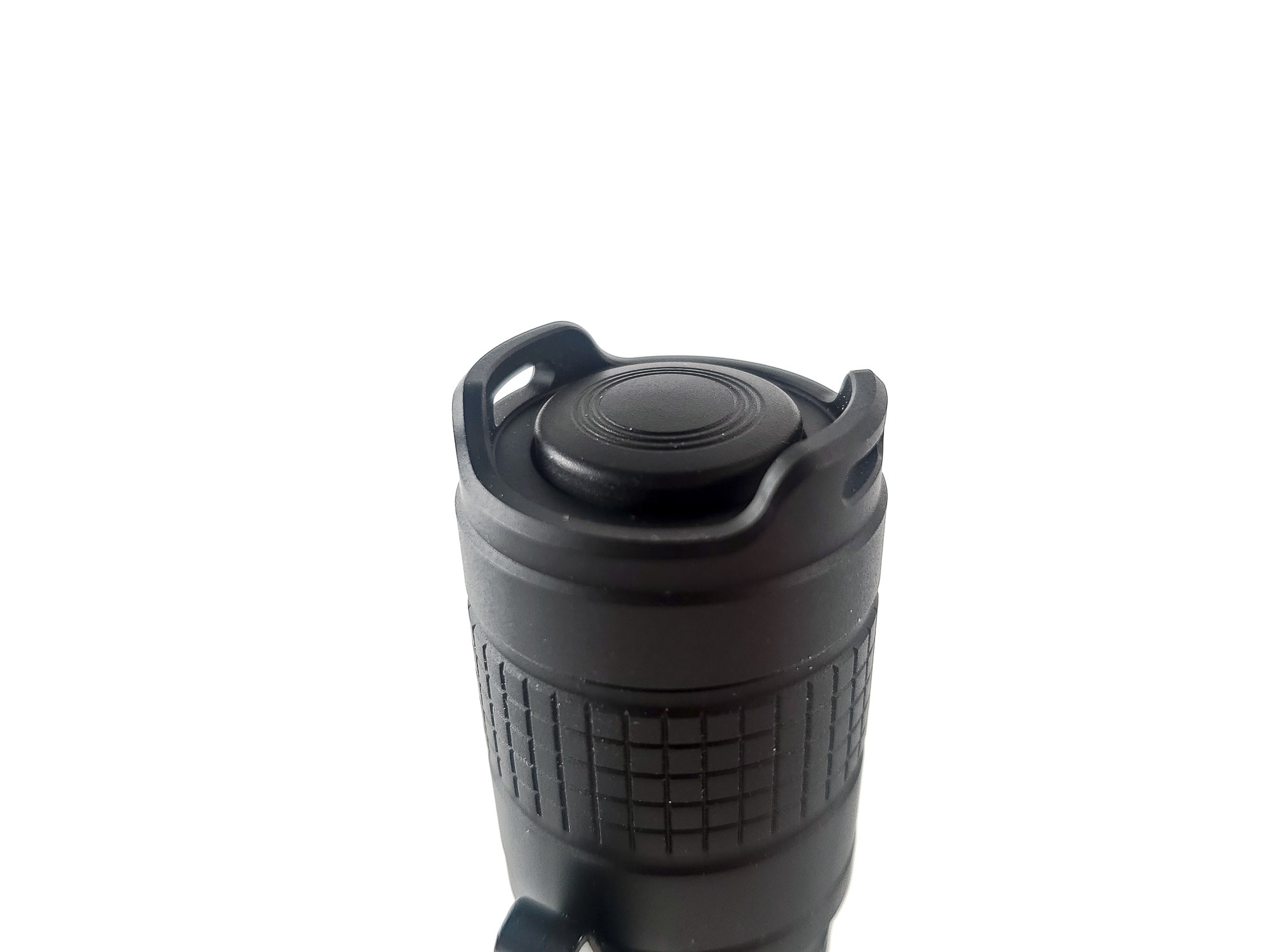
LED, Lens, Bezel, Beam, and Reflector
For the E51C, NEXTORCH decided to equip this light with an OSRAM P9 emitter. This is kept behind a glass lens and an orange peel reflector. This type of reflector will give you a softer transition between your hotspot and your spill, and usually a smooth fade out from your spill as well. Looking at the beam created, I think that description fits it to a “T”. I don’t see any evidence of an AR coating on the lens, only my smudgy fingerprints.
There are no crenulations to block your beam, but that also means no ceramic strike beads this time around (something NEXTORCH is well known for). Just a flat, black bezel. The Osram P9 is a formidable choice as it provides an efficient beam at a lower cost, but a drawback is it can be on the green side. Personally, I prefer warmer tints, and this came in between 6250k and just under 6500k. The brighter it got, the cooler the temperature became.
And while not fantastic if you deem yourself a tint snob, the P9 emitter brought out colors in the form of color rendering readings between 73 and 75 CRI. These readings were all taken with my Opple Lightmaster Pro at 4 feet. As far as the actual beam pattern goes, the hotspot and the spill are both incredibly soft. The hotspot is surrounded by a corona which is also soft in appearance but unfortunately the tint comes out in spades. It is a not-too-attractive greenish yellow and is on the unpleasant side of my preferences. This beam is perfectly usable, but since this is touted as an EDC flashlight, instead of just a tactical carry, I would have loved to have seen at least a better binning of the P9 emitter installed.
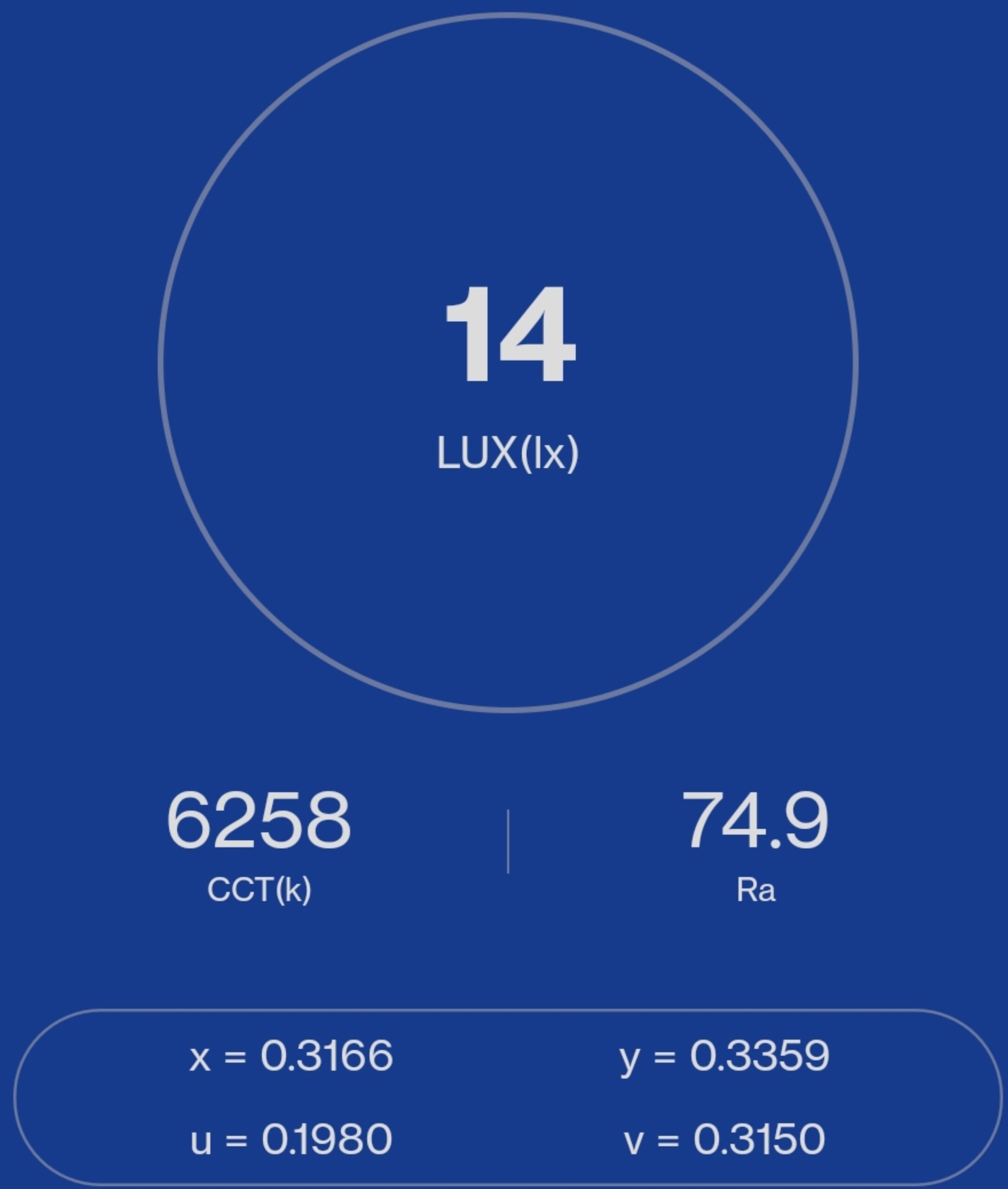
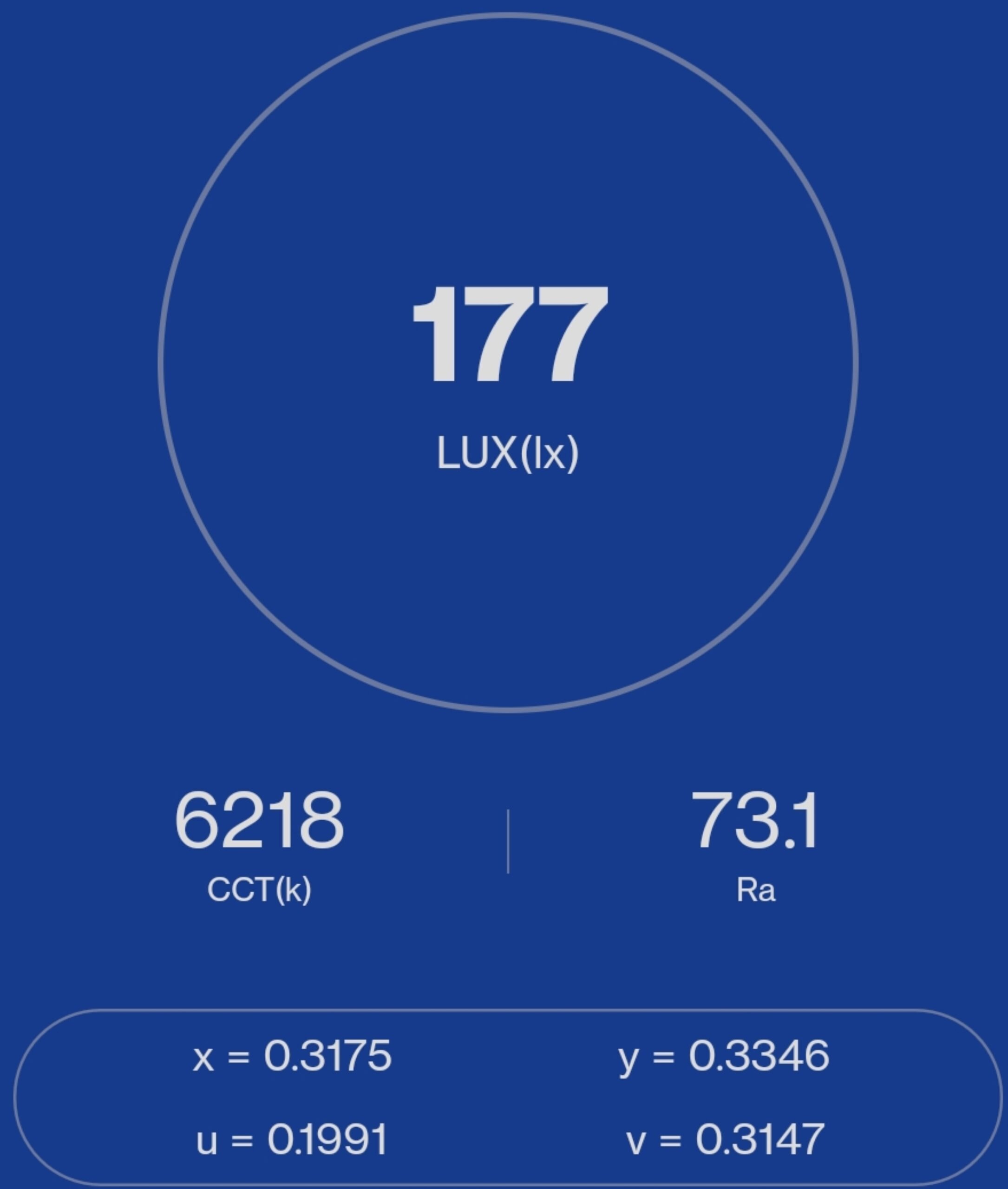
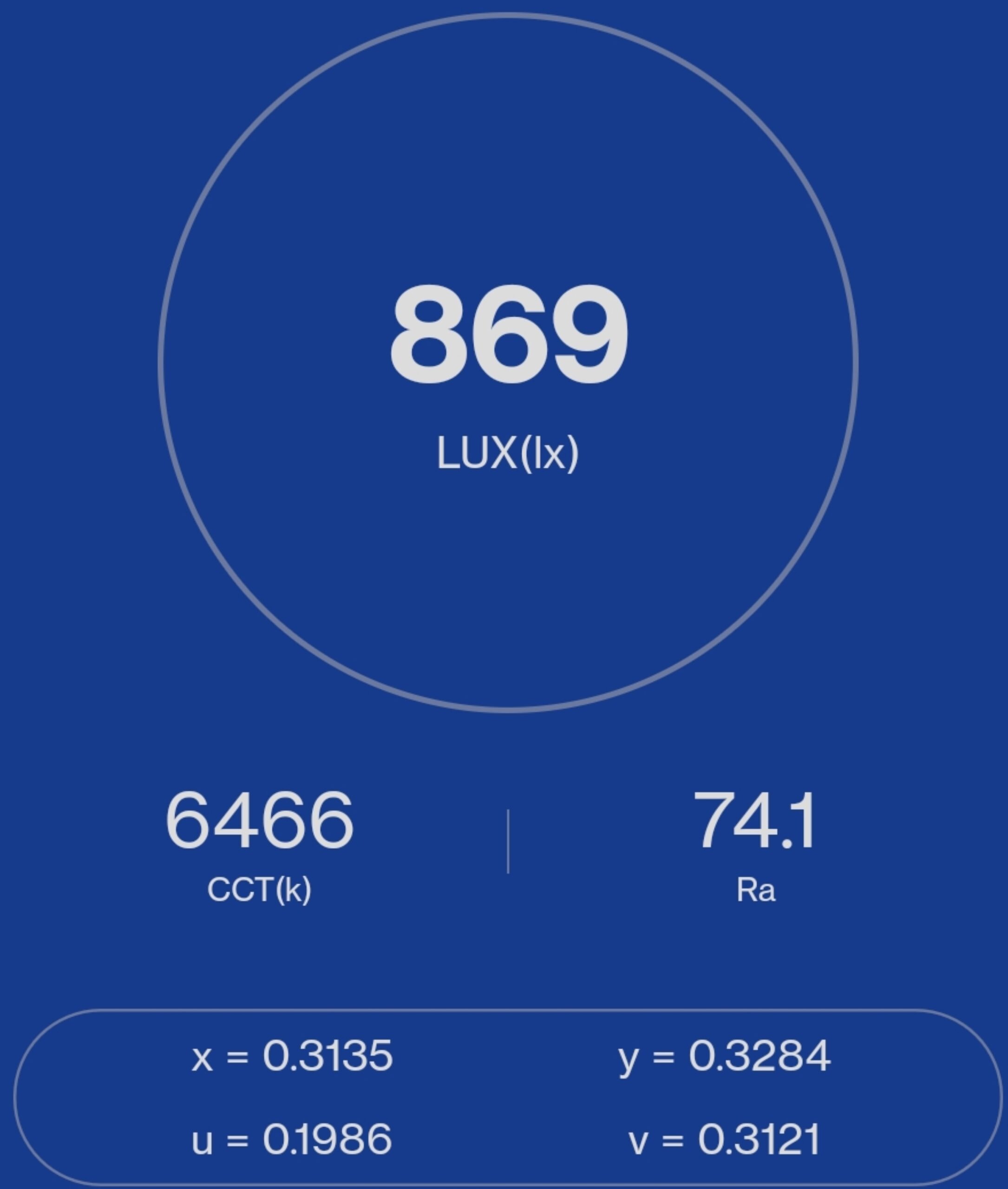
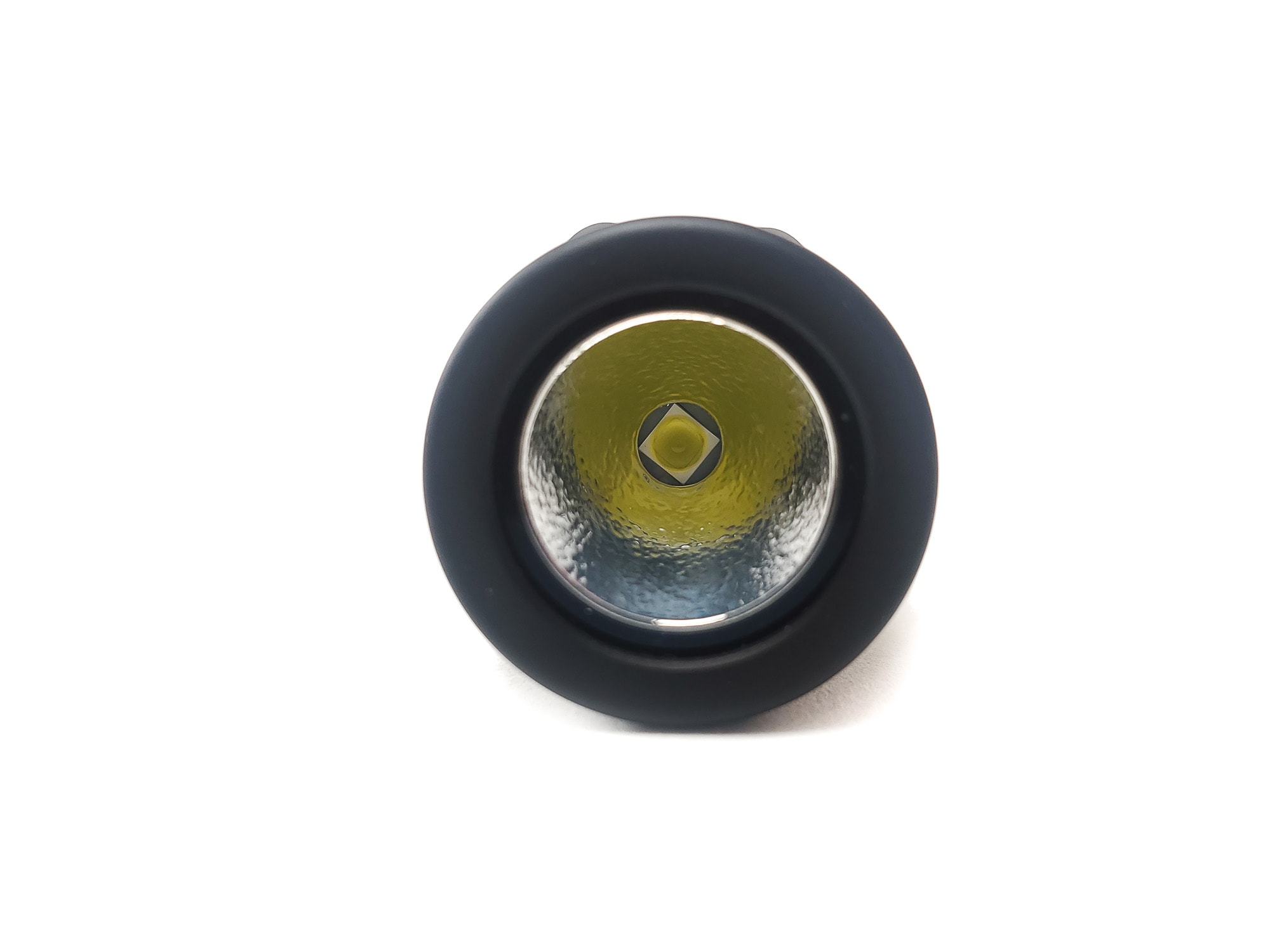
Dimensions and size comparison
Dimensions:
| NEXTORCH E51C | Millimeters | Inches |
|---|---|---|
| Length | 140 mm | 5.5 in |
| Head diameter | 27 mm | 1.1 in |
| Body diameter | 23 mm | .9 in |
Dimensions are rounded to the nearest millimeter, and to the nearest tenth of an Inch.
Weight:
| NEXTORCH E51C | Weight in grams | Weight in oz |
|---|---|---|
| Without battery: | 91 g | 3.2 oz |
| With battery | 144 g | 5 oz |
Weight is rounded to the nearest gram, and to the nearest tenth of an Oz.
Flashlight size comparison with its competition:
Group 1: NEXTORCH E51C, NEXTORCH TA30 MAX, NEXTORCH TA30C, Wurkkos FC12. Sofirn SC32
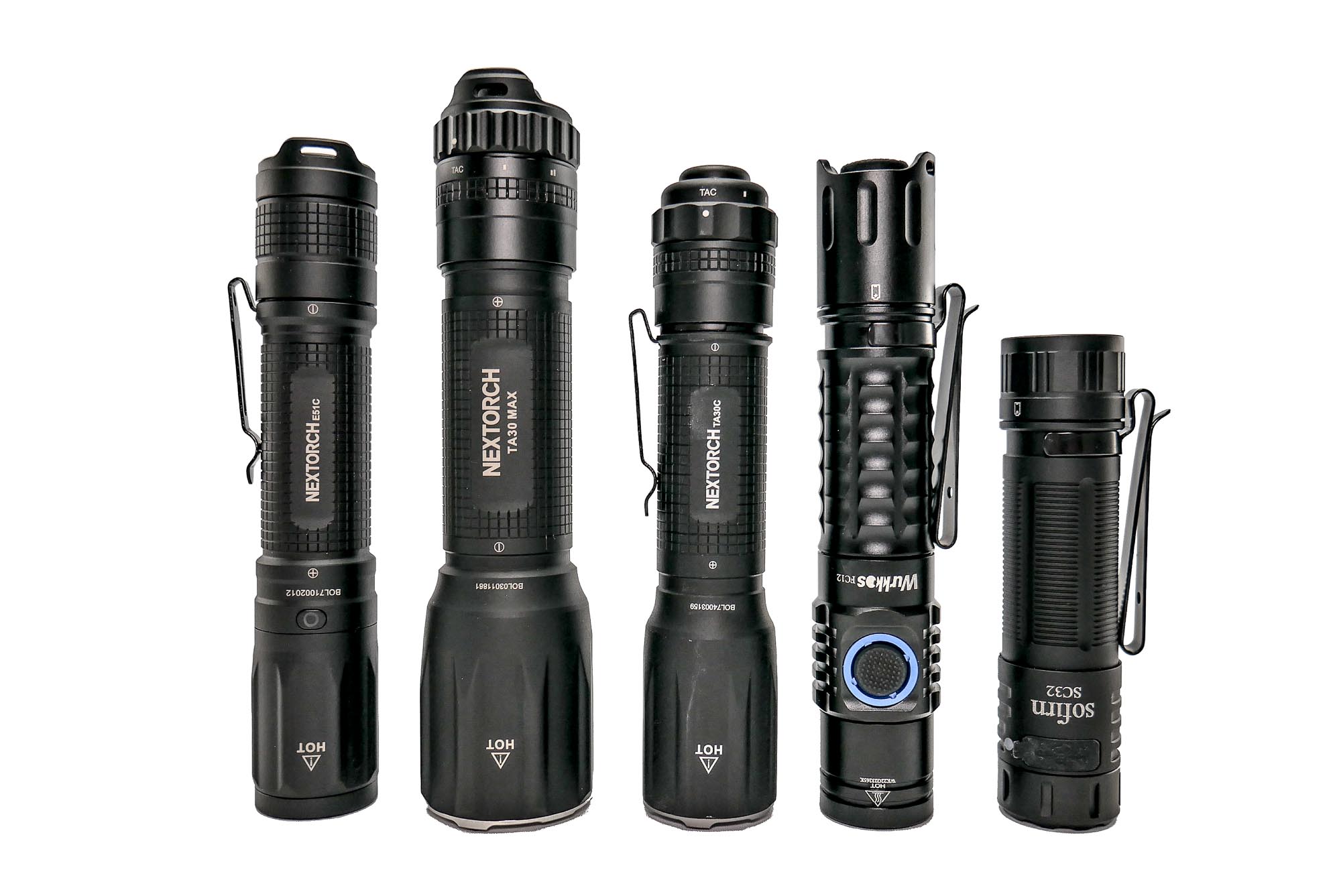
Driver & User Interface:
Since the E51C has a forward-clicky switch, you make half presses to select your output level and once you are “on your selection” you continue with a full press to lock it in. Once you have made this selection, the only way you can change your mind on what mode you have is to shut the light off and start again.
This is something that I miss from other rear magnetic rotary switch lights I have tested from NEXTORCH. If it were reverse clicky, you would be able to have the light on and change modes, but you would lose access to instant, momentary high if the light were already on. The best of both worlds would be an e-switch, but that would require a complete software redesign. I understand why they chose the input method they did, but you don’t always need or want to start off in high mode, and that isn’t an option here.
A mode memory would have been a very welcomed addition since the switch is already intelligent enough to differentiate presses and engage strobe. The strobe is engaged with a quick double half-press for a momentary strobe or a half press and click to lock it into that state. All things considered, I do like that they kept the strobe, even though it could be considered by some irrelevant on an EDC light, but the inclusion on the E51C is quite welcomed. The UI is easy to figure out, and while there are a few quirks (namely the lack of memory mode), it is easy to navigate and control.
Available modes:
- Low, Medium, High
Available blinky modes:
- Strobe
From OFF:
- Half Press: Instant High Mode
- Successive Half Presses: Switch Between Output Modes
- Click (when mode has been selected): Lock in Current Mode
- Double Half Press: Momentary Strobe
- Half Press and Click: Lock in Strobe Mode
From ON:
- 1 Click: Off
Mode memory:
- No memory mode. The first setting is always High.
Shortcuts:
- To Strobe: Double Half Press for momentary or Half Press and Click to lock in that mode.
Low voltage warning:
- The battery indicator will flash red when the battery is almost depleted.
Strobe/blinkies
- Strobe will activate with a double half-press for momentary or a half-press and click to lock it in strobe mode.
Lock-out mode:
- No intended lockout, but you can disengage the circuit by a twist of the tail cap as the threads are anodized.
PWM
- No PWM was visible, either by the naked eye or using the ol’ cell phone camera trick.
Batteries & Charging
The battery that NEXTORCH has paired the E51C with is an 18650 battery with a capacity of 2600 mah. The designator it has received is a DC0076H. Standing 70mm tall with a flat bottom and a button up top, it seems to fit the dead center of spring travel. These springs are quite short though, so I would be cautious of running any larger of a cell.
I additionally tested the size of the battery tube with a shorter 67mm button from a different manufacturer, as well as a flat top that came in even shorter at 64mm and things still fit quite snug inside. With both of these cells, I did try to test the limits of the light and give it a “slam test” to see if any contact would be lost. Fortunately, this didn’t happen in the slightest and the light kept on shining.
Back to the included battery, when the light finally fell below the LVP limits, I was able to unscrew the head of the light and expose the USB-C charging port that is o-ring sealed to maintain it water-tightness. This low voltage protection threshold came about between 2.67 and 2.69 volts, depending on what cycle you look at the data for. Plugging the included cable into a 65w capable power brick, I was able to achieve a maximum charge rate of 1.75 amps. This slowed down after 45 minutes and hovered around .66A until the charging cycle had completed at 1hr and 32 minutes.
Also when the cycle completed, the battery indicator just under the threads changed from red to blue. The design of this concealed charging port makes me feel like it would be more water tight than just a rubber plug on the head, but at the same time, there is a little bit of added time getting to the port.
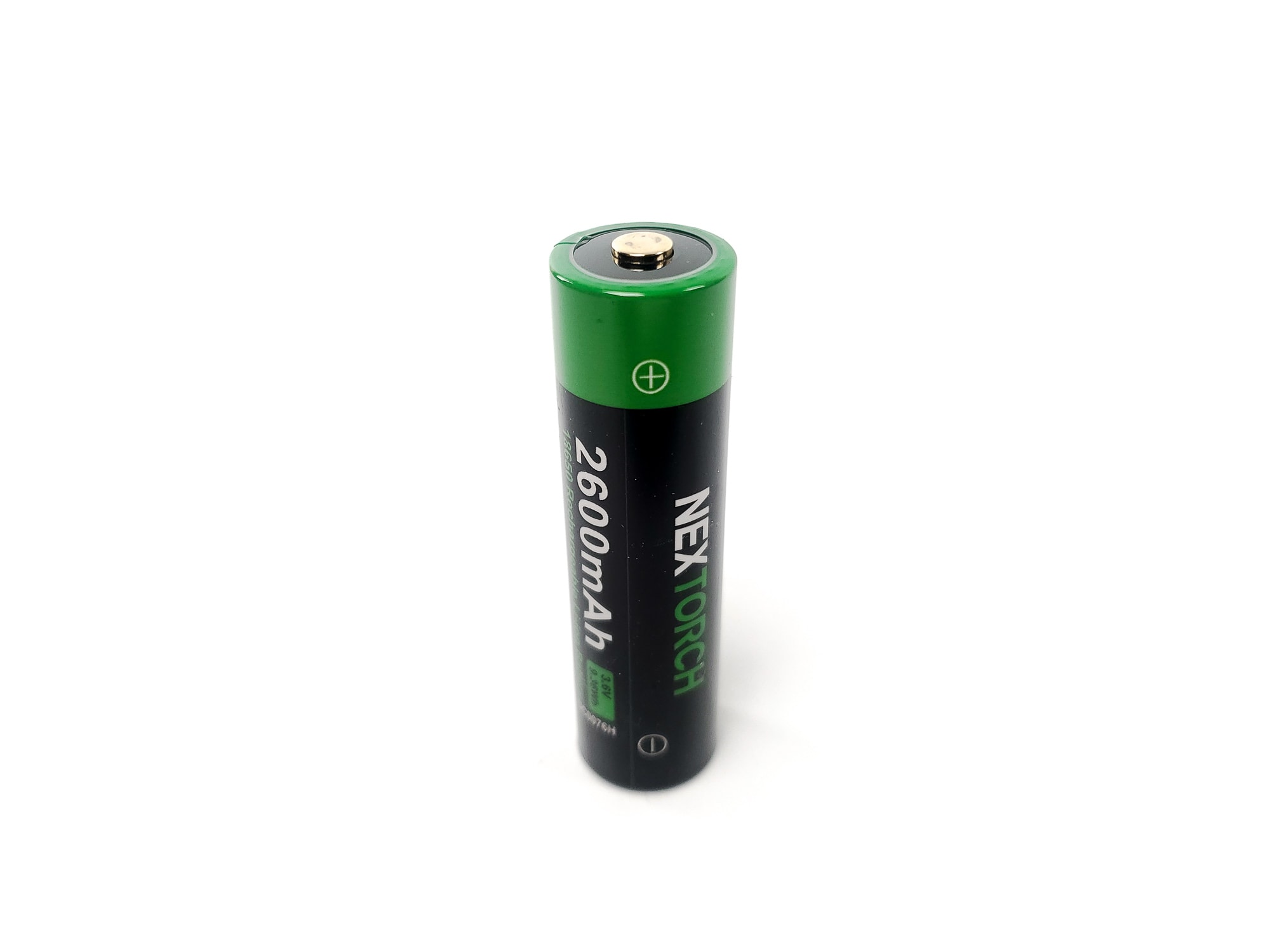

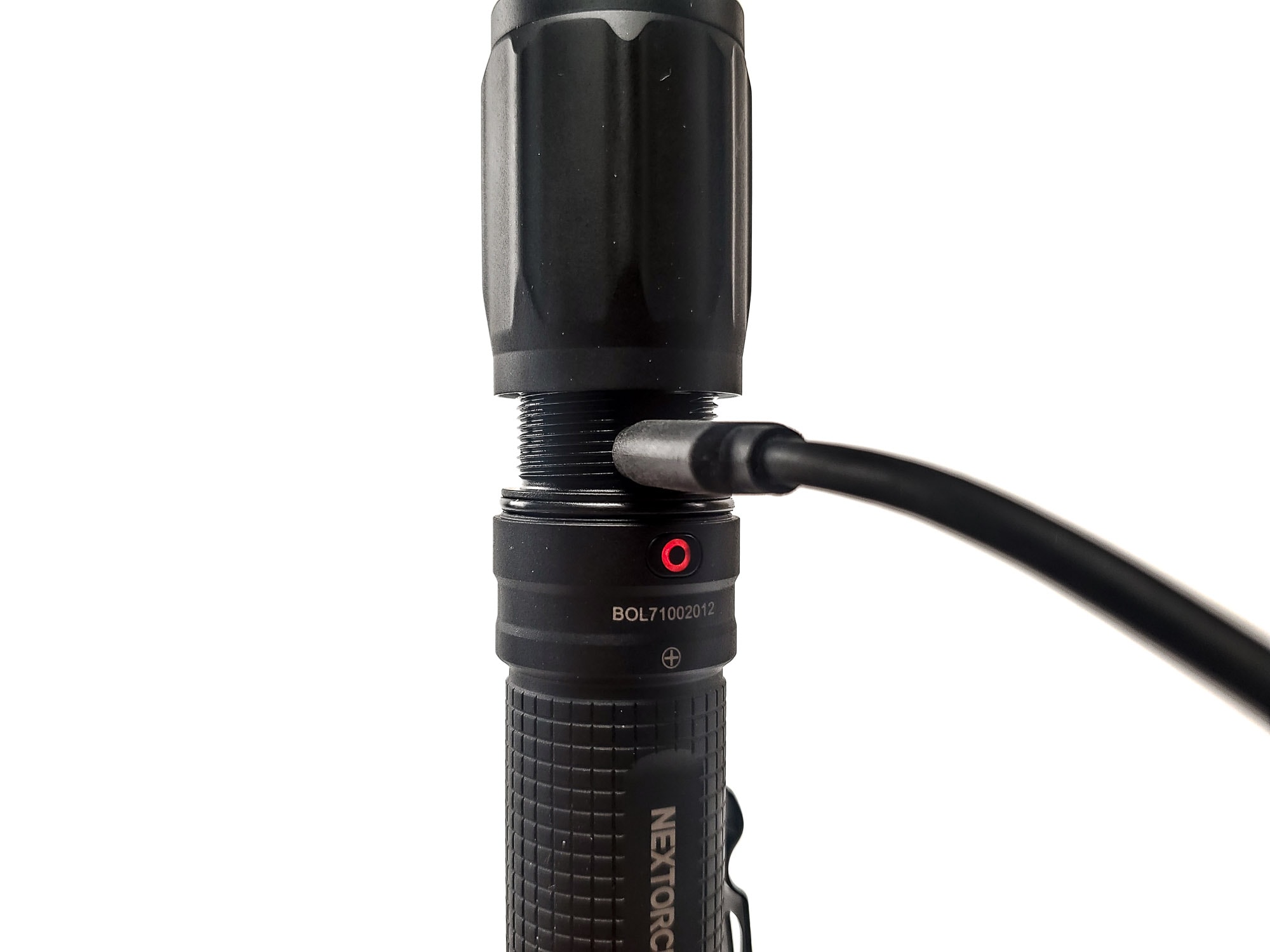
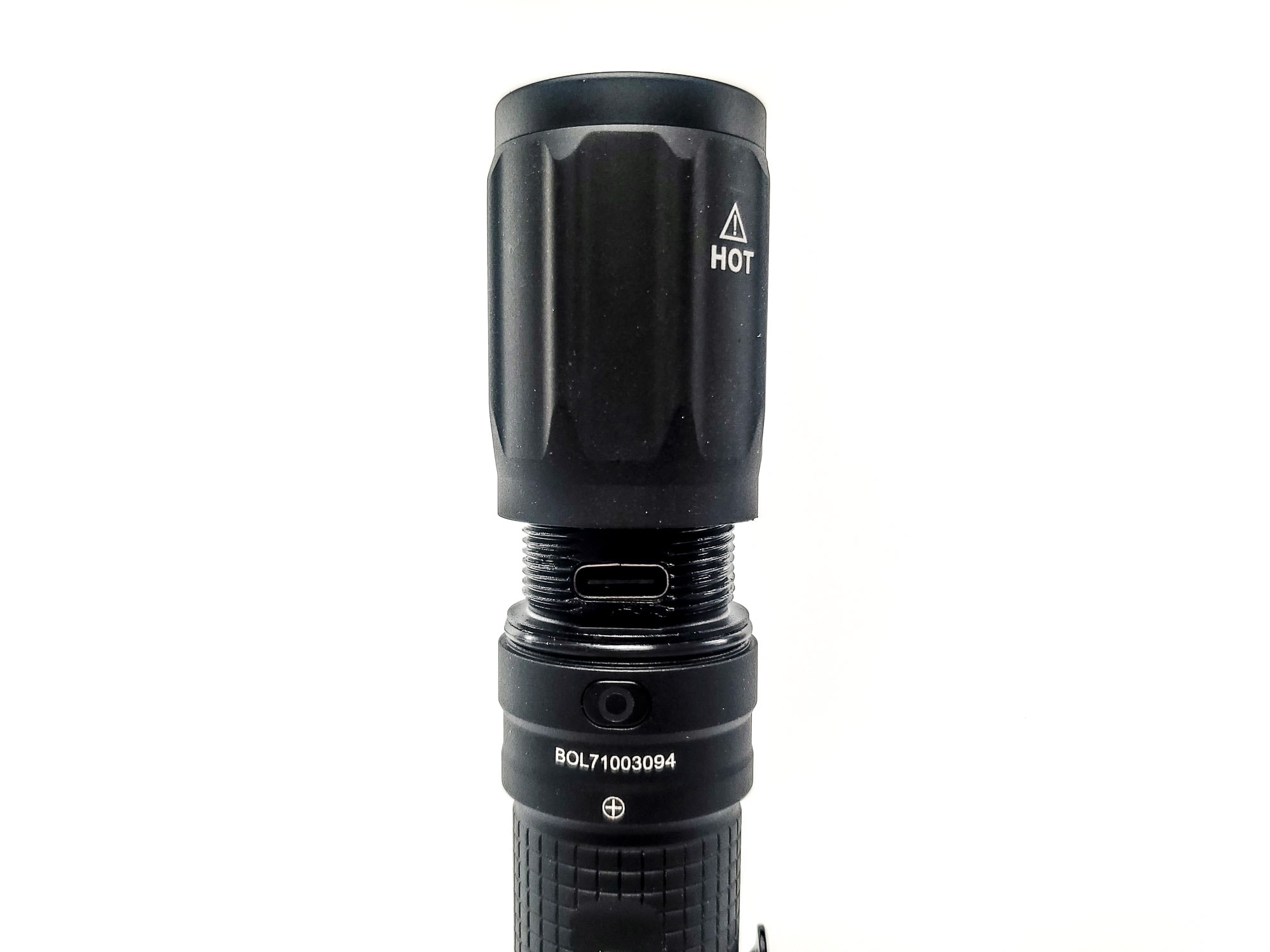
Performance test
For my output measurements, I utilized a purpose built integrating sphere and an ExTech SDL400 datalogging light meter. These figures were compared to a tested, known light source. All tests were performed with the included battery after a complete charge cycle.
Lumen measurements (for each mode)
| Mode | Specified | turn on | 30 sec | 10 minutes |
|---|---|---|---|---|
| Low | 28lm | 26lm | 26 lm | 26 lm |
| Med | 340lm | 326lm | 324 lm | 321 lm |
| High | 1600lm | 1510lm | 1488 lm | 415 lm |
Battery Life: Runtime graphs
I ran through low, medium and high with the included battery freshly charged (until the charging indicator turned blue) and performed all tests until the light shut off.
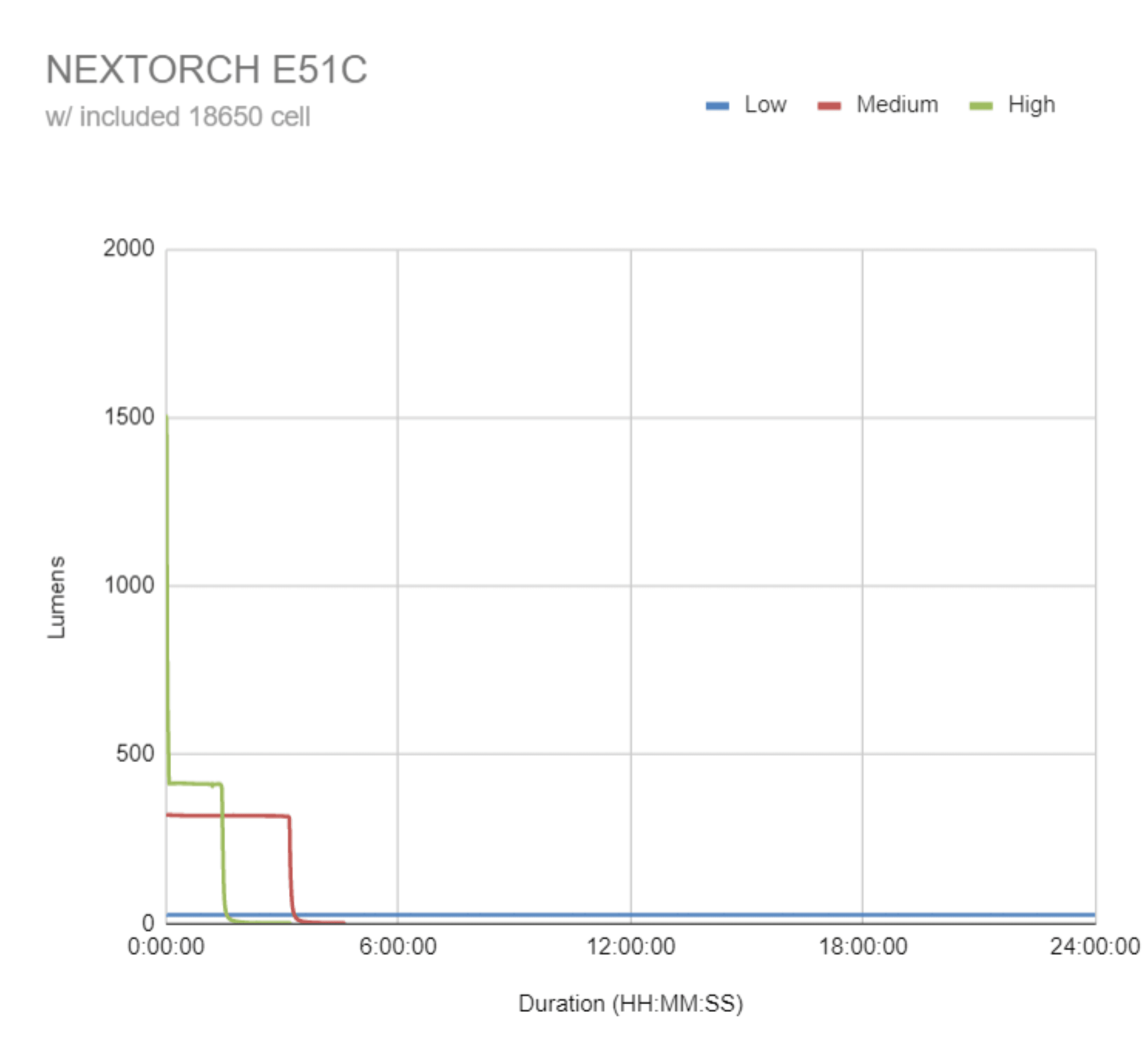
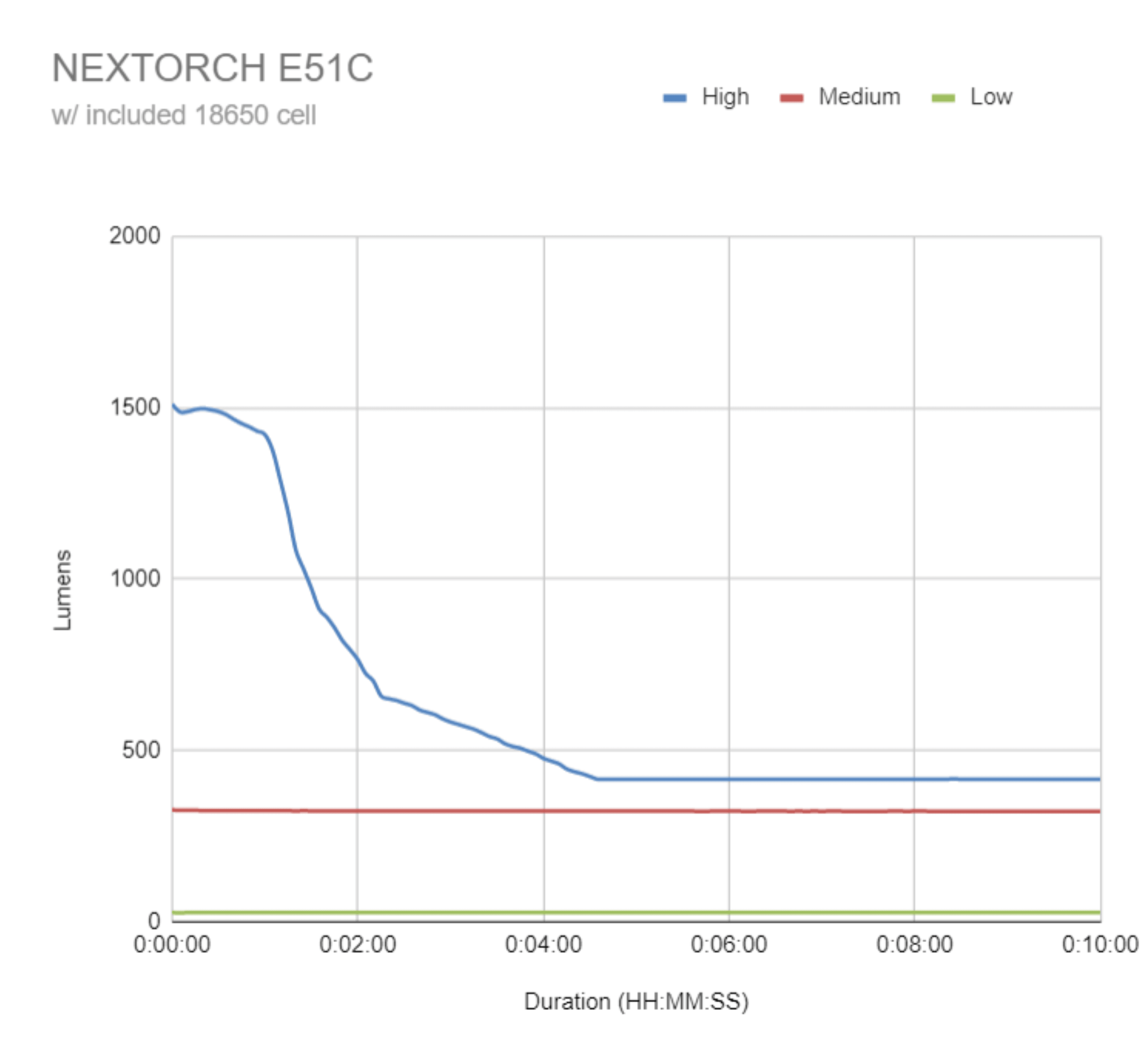
| Mode | Specified | Measured runtime ANSI | Time till shut off |
|---|---|---|---|
| Low | 43h | 24h+ | 24h+ |
| Med | 4h 45min | 3h 17min | 4h 36min |
| High | 2h 30min | 1h 29min | 3h 12min |
I cannot attest to the entire runtime for low mode as I stopped my test at the 24hr mark. As far as the medium and high modes, the runtimes do not seem consistent with what I would have expected at all. High? That came in at 60% of its expected runtime. On medium, I can only assume that NEXTORCH used full runtimes instead of ANSI ratings.
ANSI FL1 standards: The runtime is measured until the light drops to 10% of its initial output (30 seconds after turning on). This does not mean that the flashlight is not usable anymore. The last column shows how long the light actually works till it shuts off. If there is a + symbol, it means that the test was stopped at that particular point, but the light was actually still running. This happens on certain occasions, with certain drivers, firmware, or batteries.
Peak beam intensity and beam distance measurements
Tested at 30 seconds in each mode Using an Opple Lightmaster Pro at 10m.
| Mode | Specified | Candela measured | Meters | Yards |
|---|---|---|---|---|
| Low | 25 meters | 181 cd | 27m | 30yd |
| Medium | 102 meters | 2920 cd | 108m | 118yd |
| High | 205 meters | 11,706 cd | 216m | 236yd |
These measurements were pretty close to spec, which is peculiar, given the light seemed to be underperforming in output and runtime.
Extra info: Peak beam distance according to ANSI FL1 standards: The calculated value of distance in meters at which the flashlight produces a light intensity of 0.25 lux. (0.25 lux is about the brightness of a full moon shining on an object). The columns ‘Meters’ and ‘Yards’ use rounded numbers.
Beamshots
Camera settings and distance: All photos taken using a Panasonic Lumix G7 locked at 5000 ISO, ev 0.0 at 70y
Beamshots of the following flashlights compared:
- NEXTORCH E51C
- NEXTORCH TA30C
- NEXTORCH TA30Max

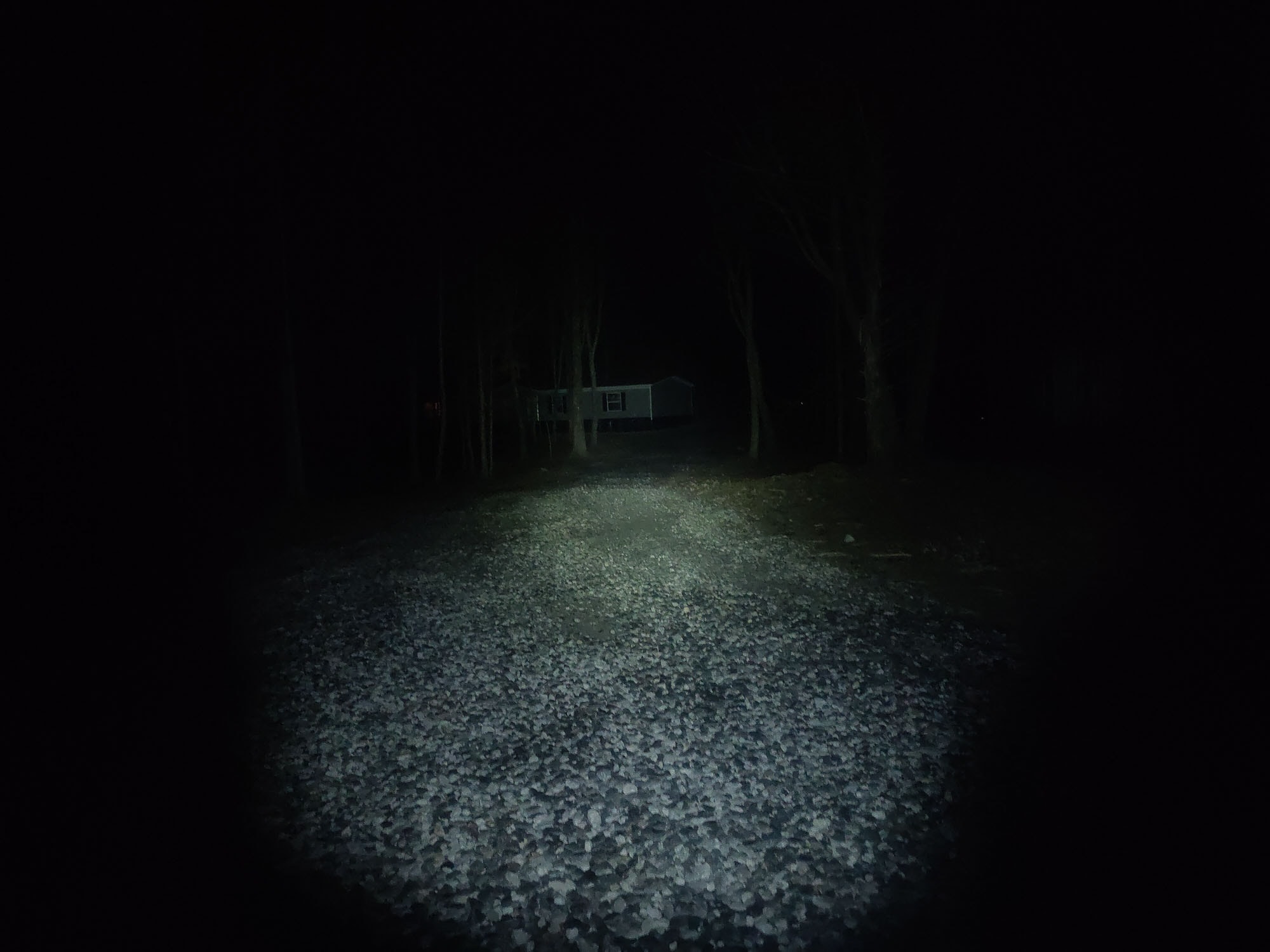
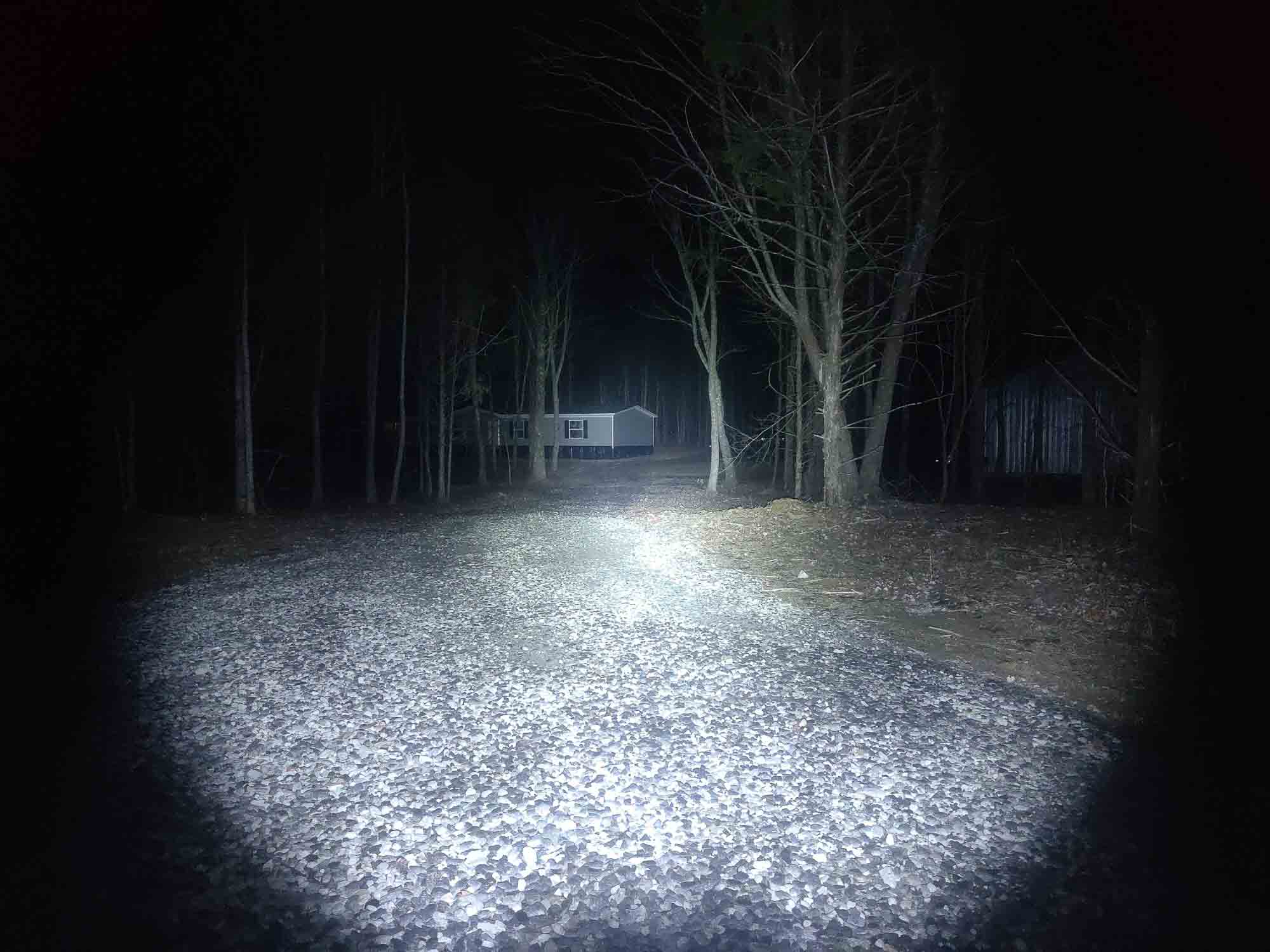
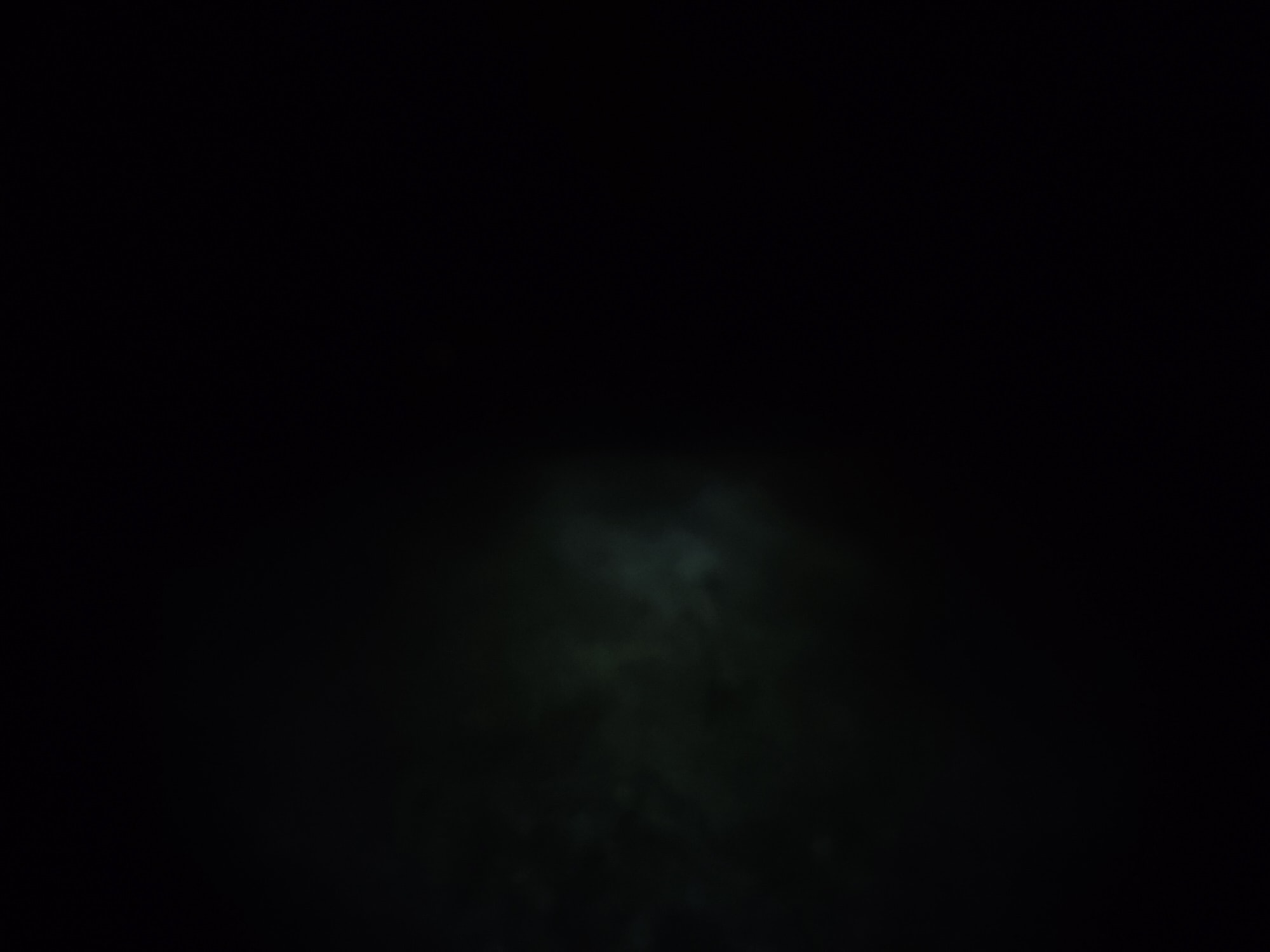
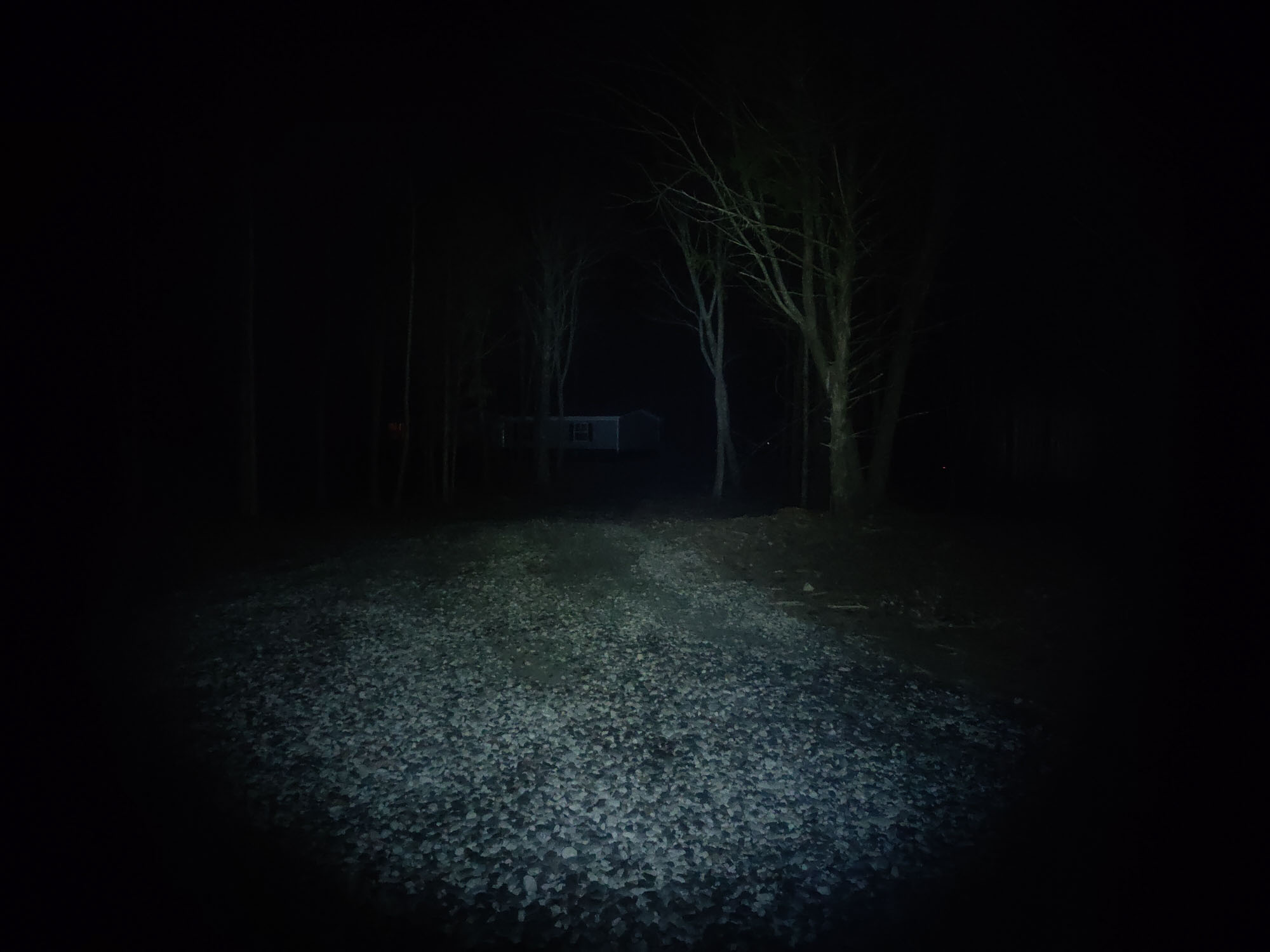
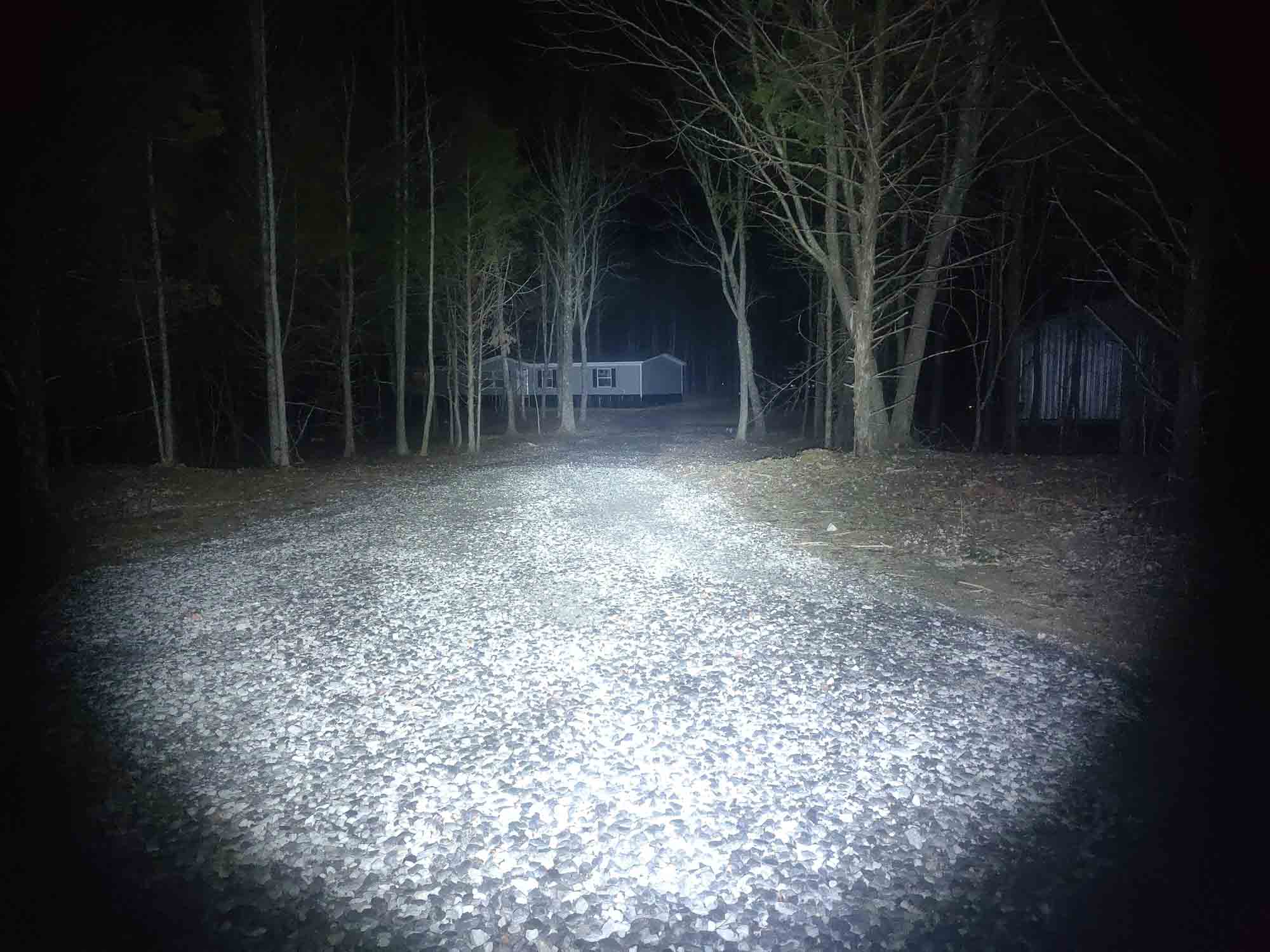

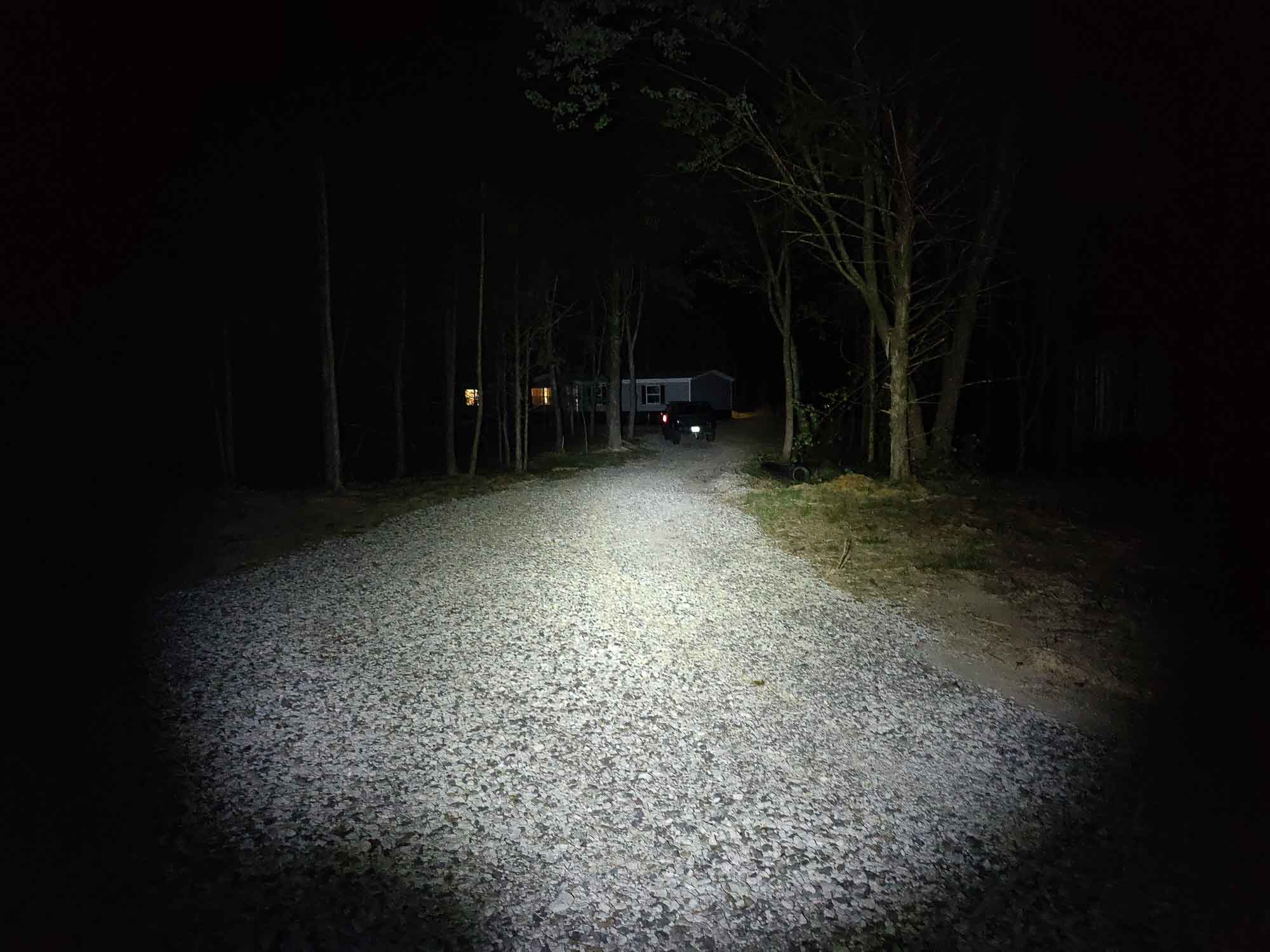
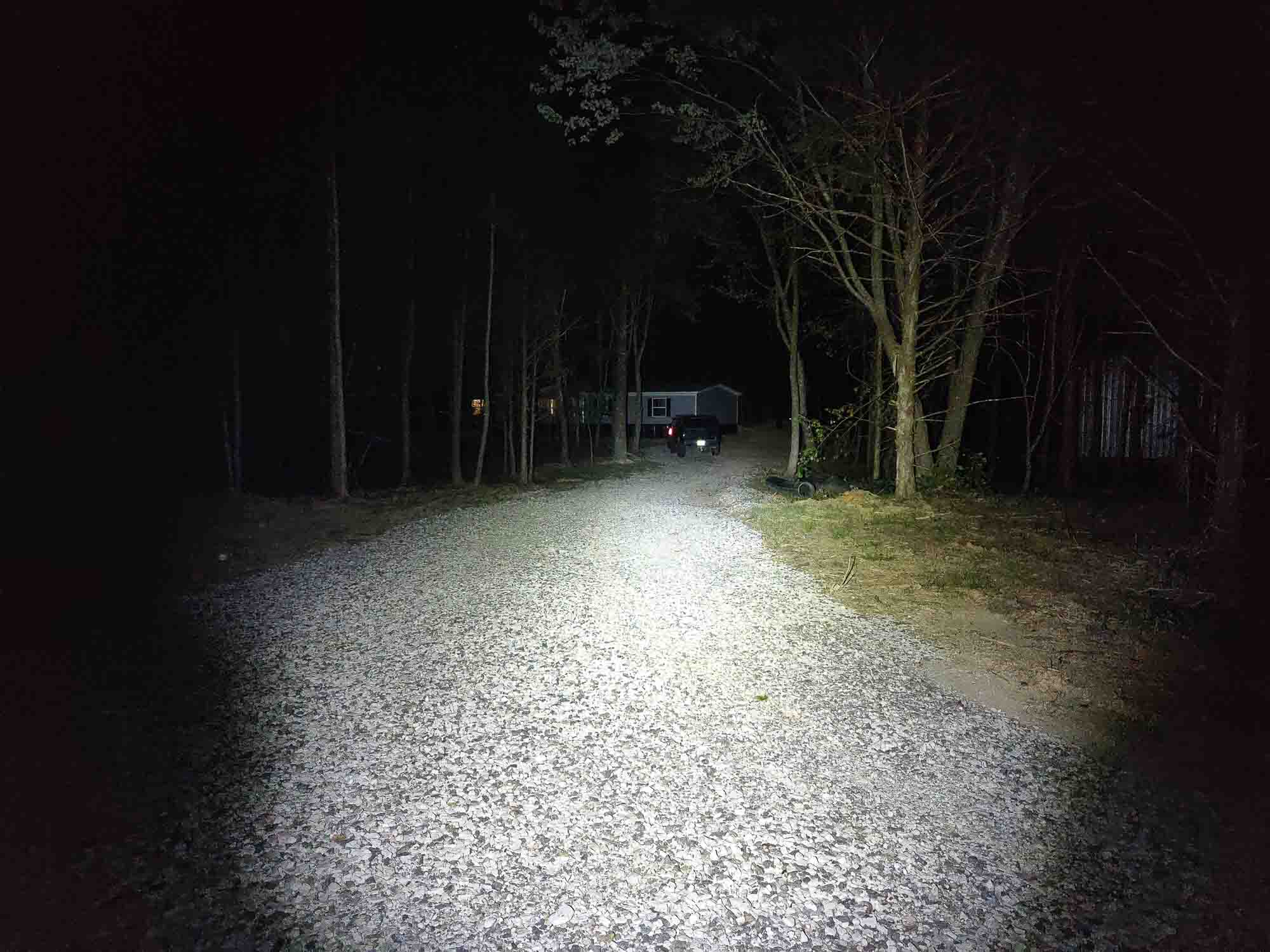
Disclaimer: This flashlight was sent to me for review at no cost by NEXTORCH. I have not been paid to review, nor have I been holding back on problems or defects.
Final Verdict
Pros
- Slim profile makes it truly pocketable
- large window for momentary
- Very sturdy with great fit and finish
- USB-C onboard charging
Cons
- Rear switch feels kind of vague
- Under Spec on ANSI runtimes
- UI ALWAYS starts in High / No memory mode
- Small battery capacity
- Sold as EDC, but feels like it teeters on tactical
Explanation on star ratings:
1: Avoid: a match would be a better choice – 2: Poor: significant defect or issues; almost unusable – 3: Average: some defects or issues; but still usable 4: Good: recommended (minor issues) – 5: Great: highly recommended
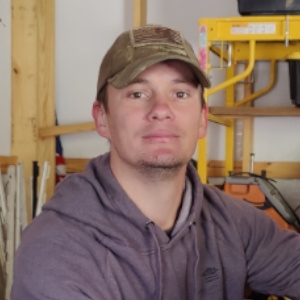
3.5 stars: ★★★⋆
Truth be told, It was kind of weird holding a NEXTORCH light that wasn’t specifically designed for tactical use. There are some things that they excel at, and while this light performs well, It just didn’t seem like a normal NEXTORCH to me. With the slender feel and a single rear switch, I don’t know if EDC would be the correct designator for this light. You are limited to a tactical hold, or using two hands, for changing modes but most of the time, I would opt for a tactical hold. Seems kind of counter intuitive for an EDC light if you ask me.
Ultimately, It is hard to judge the E51C as either an EDC or a tactical light, since it has great features, but they seem to fall just shy of what you would expect in either category. Its savior, in my eyes, is that there is finally onboard USB-C charging. Quite a few rotations to unscrew the cap, but onboard nonetheless.
Not expected when I first opened the box to another NEXTORCH light, but because of the small nuances I could find, It felt fitting to rate this particular NEXTORCH addition as 3.5 stars. Now mind you, this is as an EDC light. As a tactical light, even without some very “tactical features” the score would improve to 4 stars.
Buy NEXTORCH E51C here
Get 10% off at NEXTORCH using our exclusive discount code: 1lumen10
1lumen selects and reviews products personally. We may earn affiliate commissions through our links, which help support our testing.